Abstract
The purpose of this paper is the assessment of the ISO 14001:2015 transition process among Portuguese ISO 14001 certified organizations, including those that successfully have already achieved ISO 14001:2015 certification. A considerable number of the surveyed companies proceeded with the transition to the ISO 14001:2015 by introducing slight adjustments and were supported by external consultants. Nearly all of the respondent companies (97%) intend to transition until 15th September 2018. The highest ranked reported benefit is the “integrated approach with other management sub-systems” with a well-consolidated perception from the surveyed companies. This is aligned with the ISO 14001:2015 goal of improving the compatibility of management standards supported on the Annex SL. “Alignment with business strategy”, “improved top management commitment” and “improved internal and external communication” are also perceived to obtain significant benefits from ISO 14001:2015. The statistical tests carried out (Kruskal–Wallis) confirmed that the perception of some achieved ISO 14001:2015 certification benefits is dependent on the size of the organization. Concerning the motivations to proceed with certification, results suggest that there is not a particular company profile that is compelled to certify their EMS based on a specific type of motivation (Internal or External). Due to ISO 14001:2015 novelty, these exploratory results should be subjected to additional research confirmation.
1. Introduction
Traditional approaches aiming at environmental protection often rely on legal frameworks to enforce measures and behaviors in organizations. The 1992 Rio de Janeiro summit on Environment and Development with the approval of the Framework Convention on Climate Change, the Convention on Biodiversity, the Declaration on Forests and the Agenda 21 triggered an increased international emphasis for the development of environmental sustainability and for more environmental friendly products and services. Within this context, the demand for voluntary environmental management systems (EMS) certification has shown a constant rise, which has been depicted by trends of ISO 14001 international standard certification. ISO 14001 has reached 300,000 certificates in 2016 and seems to mimic the same success path as the widely adopted ISO 9001 Quality Management System international standard, which has more than 1,200,000 issued certificates worldwide [1]. ISO 14001 is an International Standard supported on the assumption that better environmental performance can be attained when environmental aspects are systematically identified and managed through pollution prevention, improved environmental performance and compliance with applicable laws [2].
To ensure that ISO 14001 remains updated and relevant for the marketplace by addressing the latest trends and improving compatibility with other management system standards, such as ISO 9001, ISO revised and issued the 2015 ISO 14001 edition [3]. ISO 14001:2015 proposed some new and reinforced approaches, such as the adoption of the Annex SL structure; the requirement demanding organizations to analyze their internal and internal context in order to ascertain the issues and requirements that may impact the EMS; the assignment of specific responsibilities for leaders to promote the EMS; more emphasis on the performance improvement by minimizing the water and energy consumption as well as producing less emission and waste; the introduction of a life cycle perspective that asks for organizations to extend their control and influence to the environmental impacts ascribed to product use and end-of-life treatment or disposal; and the development of an external and internal communications strategy to consider the reporting demanded by regulatory agencies and the expectations of other interested parties [2].
ISO 14001 international standard was first published on 1st September 1996, which established the requirements for EMS, including the organizational structure and the responsibilities; the planning of the activities; the definition of practices, processes and procedures; and the allocation of resources to plan, implement, check and improve the environmental policy [2,4,5,6,7].
In the last few decades, many companies aimed to improve the environmental performance of their processes [8] by implementing an EMS. The theoretical literature focusing on the motivations driving organizations to implement and certify an EMS address both external [9,10,11] and internal [12,13] factors that lead companies to implement such self-regulatory mechanisms.
Additionally, there is a considerable stream of research addressing the benefits [14,15,16,17,18,19,20,21,22,23,24] and the barriers [13,15,16,17,18] of ISO 14001 adoption and certification. A systematic review analyzed the content of 48 articles published between January 2012 and April 2017 that addressed the topic of “benefits of EMS adoption and certification”. This review provided support for this resulting in fairly positive benefits (average 2.36 in a 1 to 5 Likert type scale) for the certified organizations, although there were some observed variations [20]. The main reported benefits include the ability to manage the environmental aspects more effectively and continually improve the environmental performance; an increased environmental legislation compliance; the prevention of pollution; a lower risk level of penalties and litigation; the improvement of stakeholder satisfaction and employee morale; and the potential to access new markets and new business opportunities with environmentally aware customers. This leads to both lower operating costs and new business opportunities, leveraging the competitive position of organizations [2,13,16,18]. However, there are also some reported negative consequences of EMS implementation and certification, such as the difficulty in measuring the EMS efficiency, increased bureaucracy, higher costs, lack of employee and management EMS support and the generic nature of the ISO 14001 requirements [6,15,16]. Based on an investigation of the benefits and difficulties of adopting ISO 14001:2004 within Italian organizations, Mazzi et al. [17] concluded that the most useful requirements of ISO 14001:2004 are “environmental aspects”, “legal and other requirements”, “competence, training, and awareness” and “evaluation of compliance”. According to this research, the most difficult ISO 14001:2004 requirements to comply with are “legal and other requirements”, “competence, training and awareness”, “operational control” and “evaluation of compliance”. These results highlight that the most difficult requirements match and concur with those considered as the most useful ones.
Boiral, Guillaumie, Heras-Saizarbitoria and Tene [25] concluded that whereas the mainstream literature supports the emergence of positive outcomes after ISO 14001 adoption and certification, the research is often limited in terms of “sample, scope, variables adopted and contextual aspects” and is essentially based on managerial perceptions, which may be influenced by respondent bias. Additionally, according to these authors, positive and negative outcomes of ISO 14001 adoption may co-exist (e.g., less energy and resource consumption costs, but additional bureaucracy and paperwork).
From a theoretical point of view, the adoption of voluntary management systems standards, such as ISO 14001, can be traced back to the following theories: Freeman Stakeholder Theory [26] focusing on the importance of a firms’ relationships with critical stakeholders, which may lead to an improved performance by integrating business and societal considerations that subsequently creates value for their stakeholders; Barney [27] Resource Base View Theory considering the unique combination of resources and capabilities (internal) of each firm allowing it to be unique and different with improved performance compared to its competitors; and Meyer and Rowan Institutional Theory [28] addressing the mode of behavior of institutions as a result of societal influence, which explains why organizations converge and become similar (Fonseca et al. [29]; Tuczek, Castka and Wakolbinger [30]). By analyzing the changes introduced in the ISO 9001:2015, Fonseca [31] pointed out that it brings a stronger open systems approach (influence of the environment, dynamic perspective, need for survival) when compared with the 2008 version. Due to the commonalities of both International Standards 2015 edition, this can be generalized to the ISO 14001:2015 when compared to the 2004 version.
As of 15 September 2018, all ISO 14001:2014 certificates will be no longer valid, so ISO 14001 certified organizations should proceed with the transition process until that date. After this time, they should demonstrate their compliance in being successfully audited and certified accordingly to ISO 14001:2015 international standard by a credible and recognized certification body. This is a relevant research issue, both for scholars (since previous research did not address ISO 14001: 2015 edition) and for practitioners (that need to migrate the ISO 14001:2004 EMS to the new edition).
As part of a broader research project to study the phenomenon of the management systems standards certification, an empirical study, supported by an online survey, was designed, developed and made available to the potential respondents, which had the specific purpose of gathering knowledge of the ISO 14001:2015 transition process. The survey was carried out throughout May 2017 and yielded a total of 108 valid responses.
2. Materials and Methods
Data was collected by the means of an online survey among ISO 9001 and ISO 14001 Portuguese certified organizations by the leading Portuguese certification body. This approach is consistent with those adopted by other researchers, such as Mazzi et al. [17]. An e-mail was sent to the companies in April 2017, followed by a second call in May 2017. The data were collected anonymously through an automatic online database. The sample comprised a total of 108 Portuguese organizations simultaneously certified according to the clauses of both the ISO 9001 and ISO 14001 standards. The overall response rate was 18%, encompassing 19 organizations already certified against ISO 14001:2015 and the remaining against ISO 14001:2004. This research is included in a broader research project that aims to achieve deeper understanding of the phenomenon of management systems standards certification (e.g., Hypotheses 4 and 11 relate to an ongoing parallel research addressing Quality Management Systems—QMS). The survey was designed to include several sections, which is shown in Table 1. The detail is presented for the sections relevant to this research. IBM Social Sciences Statistical Package (SPSS) v. 22 software was adopted to conduct the statistical tests and calculations (after ordinal to numerical transformation of the Likert scale type of answers). The non-parametric Kruskal–Wallis one-way analysis of variance statistical test was used to determine whether some variables, measured on an ordinal scale, differed based on other variables (namely those related to the characterization of the company). Hence, the following research hypotheses were raised:

Table 1.
Survey structure.
Dimension 1—Benefits
Research Statement: The assessment of some benefits derived from the implementation of the ISO 14001:2015 standard differ according to the …
Hypothesis 1 (H1).
… activity sector where the organization operates.
Hypothesis 2 (H2).
… dimension of the organization (N° of employees).
Hypothesis 3 (H3).
… exposure to international markets.
Hypothesis 4 (H4).
… maturity (years) of the QMS.
Hypothesis 5 (H5).
… maturity (years) of the EMS.
Hypothesis 6 (H6).
… organizational role of the respondent.
Hypothesis 7 (H7).
… experience (years) of the respondent.
Dimension 2—Motivations
Research Statement: The motivations (internal or external) driving organizations to implement the ISO 14001:2015 standard differ according to the …
Hypothesis 8 (H8).
… activity sector where the organization operates.
Hypothesis 9 (H9).
… dimension of the organization (N° of employees).
Hypothesis 10 (H10).
… exposure to international markets.
Hypothesis 11 (H11).
… maturity (years) of the QMS.
Hypothesis 12 (H12).
… maturity (years) of the EMS.
Hypothesis 13 (H13).
… organizational role of the respondent.
Hypothesis 14 (H14).
… experience (years) of the respondent.
3. Results and Discussion
This section is devoted to the presentation and discussion of the results. The first sub-section reports the social-demographical characteristics of the sample. The second sub-section presents the descriptive statistics of the results (mainly summarized as a percentage per item assessed, average and standard deviation) and in the following section, the results of the statistical tests carried out for the validation of the hypotheses are reported and discussed.
3.1. Descriptive Statistics
The typological analysis of the respondent organizations suggests that the sample mimics and resemble the Portuguese reality concerning business demographics. Mainly small and medium enterprises (SMEs) operating at the product and service-oriented activity sectors answered the survey (Figure 1 and Figure 2).
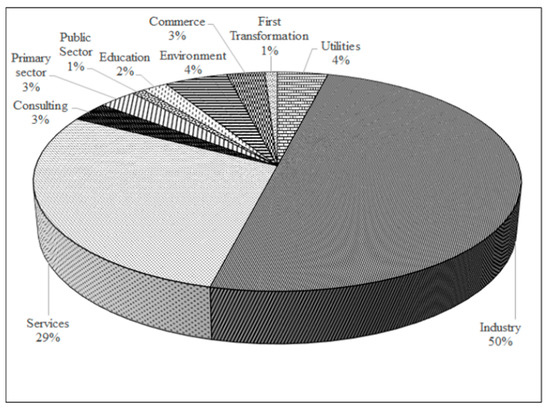
Figure 1.
Surveyed organizations—Breakdown by activity sector.
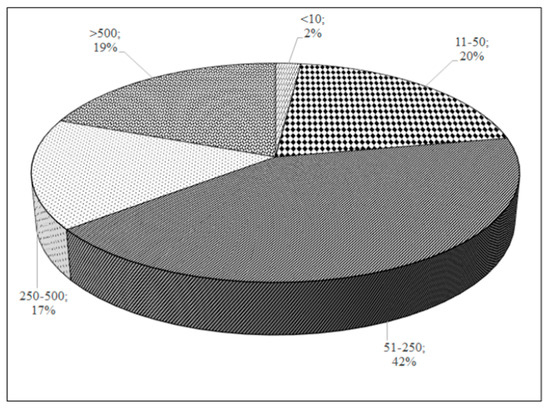
Figure 2.
Surveyed organizations—Breakdown by dimension (Nº of employees).
A considerable number of the respondent organizations (62%) develop their business activities that are mainly aimed at the Portuguese business market (Figure 3) and held the environmental management system (EMS) certification over more than 4 years (Figure 4).
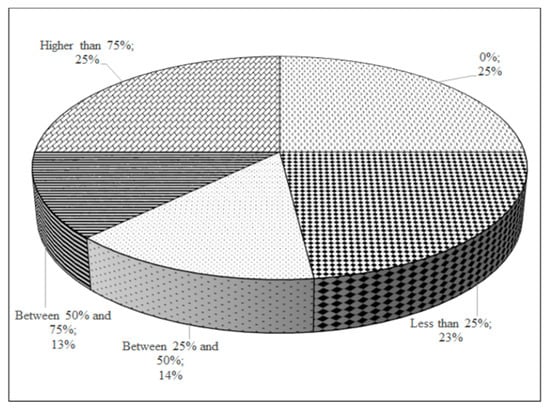
Figure 3.
International business orientation.
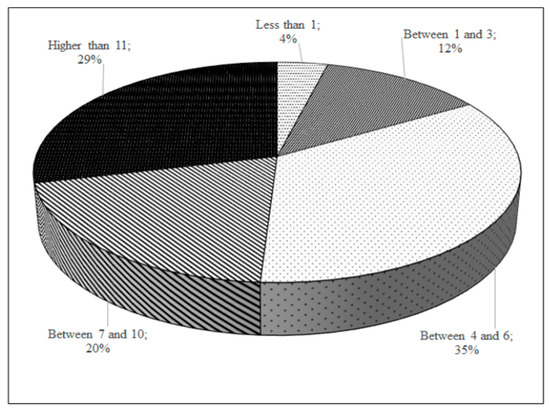
Figure 4.
Surveyed organizations—Breakdown by EMS maturity (years).
When the survey was completed online, around three quarters of the respondent organizations had not transitioned to the 2015 revision (Figure 5) due to lack of time and mandatory study and analysis of the novel requirements (Figure 6). However, the majority of the respondent organizations (97%) intend to proceed with the transition before the three-year transition period, with essentially the majority of the organizations expecting to have transitioned by 15th September 2018 (Figure 7). In addition to the major reasons pointed out previously, those organizations that did not proceeded with the transition point out some difficulties in understanding and implementing some requirements and the ascribed costs inherent to the transition process.
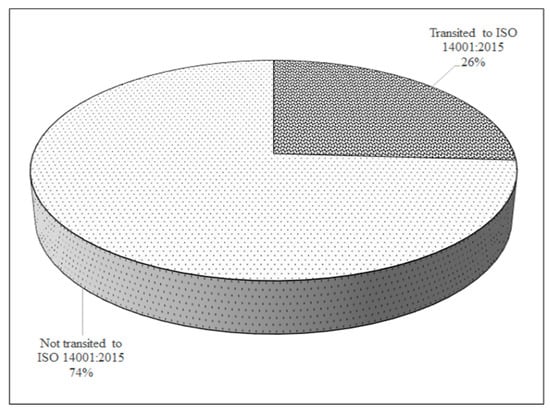
Figure 5.
Surveyed organizations- Breakdown by transition to 2015 version.
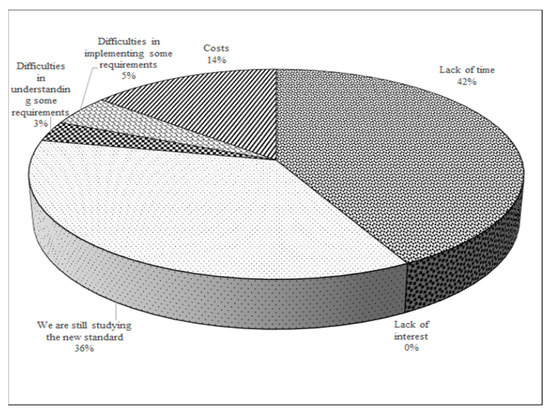
Figure 6.
Reasons for not proceeding to the transition.
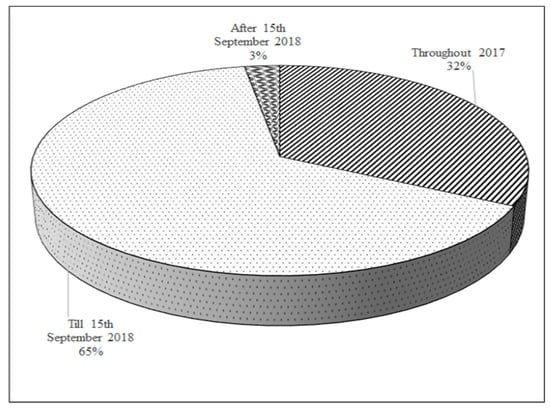
Figure 7.
Expected date for transition.
Concerning the characterization of the individual respondent responsible for the submission of the survey, it should be pointed out that these were mainly management system managers (Figure 8) that held more than 11 years of experience (Figure 9).
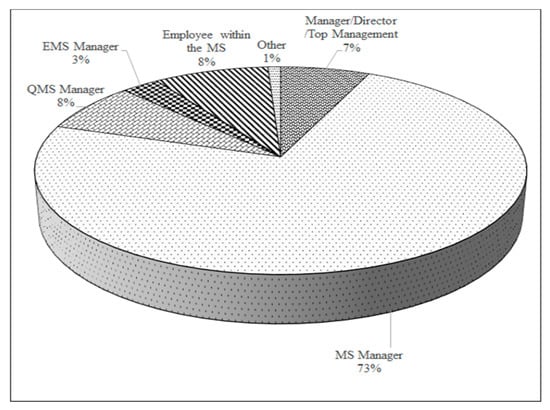
Figure 8.
Role of the respondent.
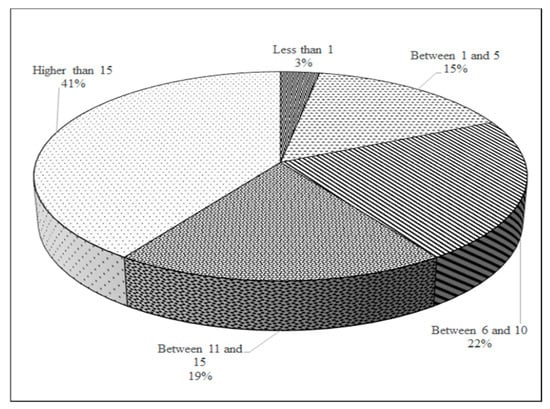
Figure 9.
Experience of the respondent (years).
3.2. Summarized Results
The results suggest that no particular resource/strategy was favored over other (Figure 10) and a considerable proportion (around 77%) of the surveyed organizations that proceeded with the transition to the ISO 14001:2015 introduced slight adjustments to the pre-existing EMS (Figure 11). Approximately one-third of the organizations proceeded with the transition and were supported solely on the available internal resources. The remaining organizations reported the support of external consultants, who carried out some training sessions focusing on the ISO 14001 new requirements (Figure 10).
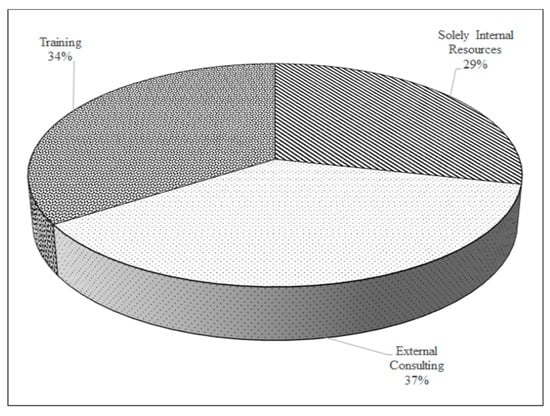
Figure 10.
Resources/strategies adopted throughout the ISO 14001:2015 transition.
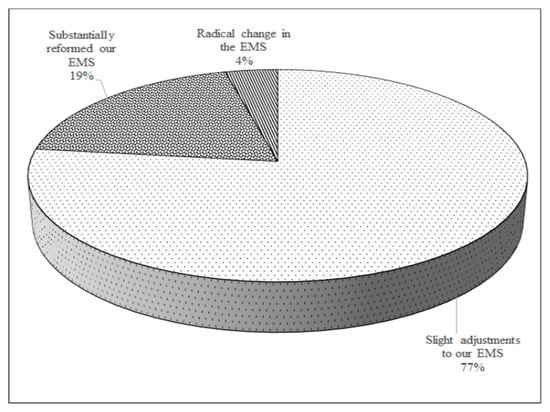
Figure 11.
Changes introduced throughout the implementation of ISO 14001:2015 revision.
Concerning the difficulties faced by the organizations (Figure 12) when implementing the new revision requirements, approximately one-quarter of the respondents pointed out the implementation of the life cycle perspective. Other noticeable items pointed out were: “risk management approach”, “context–environmental conditions” and “determining results of EMS”. Regarding the most useful concepts, nearly one-fifth of the companies found the determination of risks and opportunities, the life cycle perspective and the mapping of the context of the organization the most relevant added values (Figure 13).
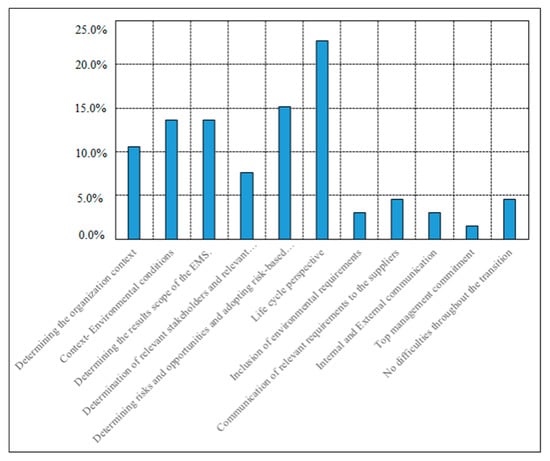
Figure 12.
Difficulties faced throughout the transition.
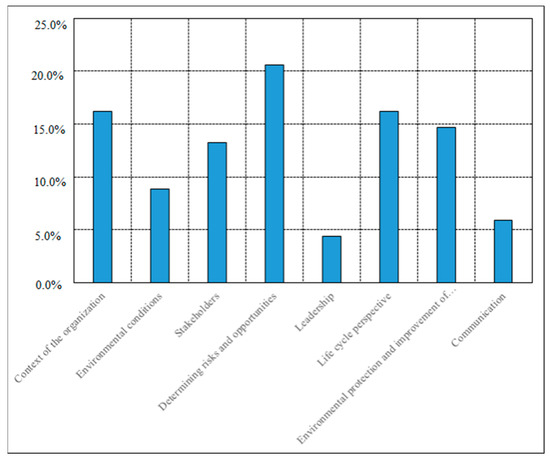
Figure 13.
Most useful concepts throughout the transition.
Concurrently, those organizations that did not yet proceeded with the transition expect the implementation of “life cycle perspective” requirement as the one which will present most challenges. Other difficulties pointed out by organizations include the “determination of risks and opportunities”, “mapping of the context of the organization” and the assurance of the “top management involvement” (Figure 14).
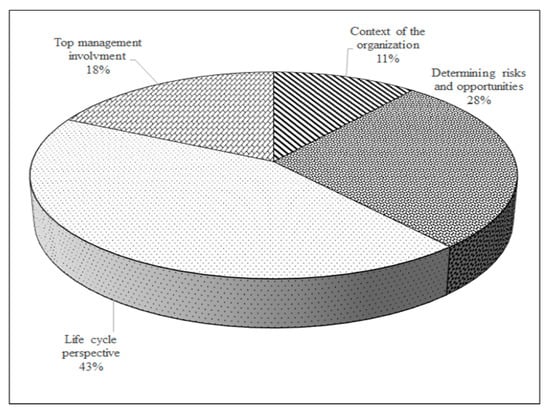
Figure 14.
Expected difficulties throughout the transition.
Table 2 presents the items assessed by variable 3.2.6—Benefits from the implementation of the new requirements of the ISO 14001: 2015 edition. Figure 15 and Figure 16 display the summarized results (average and standard deviation). The highest rated benefit pointed out by the surveyed organizations was the “integrated approach with other management sub-systems (Num_Var_3.2.6g)” and the small standard deviation suggests that this is a well consolidated perception from the surveyed organizations. This result is consistent with one of the purposes of the new revision: to improve the compatibility of the standards supported on the Annex SL. Furthermore, one should point out the benefits of “alignment with business strategy (Num_Var_3.2.6a)”, “improved top management commitment (Num_Var_3.2.6b)” and “improved internal and external communication (Num_Var_3.2.6c)”. The lowest rated benefit perceived by the organizations was “less prescriptive requirements and documentation (Num_Var_3.2.6d)”. The benefit of “improved top management commitment (Num_Var_3.2.6b)” presented the greatest standard deviation (Figure 16), suggesting that it is not perceived consistently among the surveyed organizations.

Table 2.
Assessment of the benefits from the implementation of ISO 14001:2015.
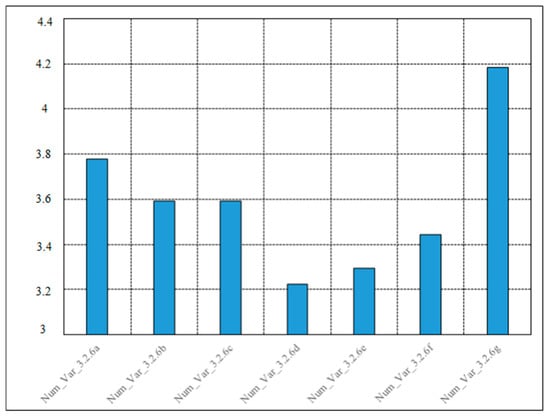
Figure 15.
Benefits from the ISO 14001:2015 implementation—Average.
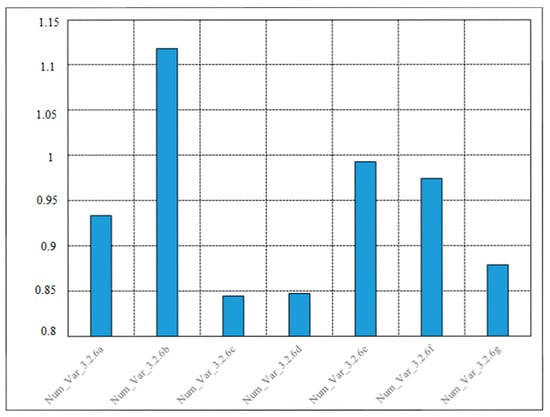
Figure 16.
Benefits from the ISO 14001:2015 implementation—Standard deviation.
3.3. Statistical Tests
The Kolmogorov–Smirnov and the Shapiro–Wilk statistical tests were used to evaluate the normality of the distribution of the results collected (Table 3) and decide the tests to be used for the research questions. The statistical tests show that the results did not have normal distribution (Sigma ≤ 0.05) and therefore, the Kruskal–Wallis statistical test was used to ascertain and validate the statistical hypotheses formulated.

Table 3.
Normality tests (Kolmogorov–Smirnov and Shapiro–Wilk).
Table 4 and Table 5 present the results from the Kruskal–Wallis statistical test (Asymptotic Sigma). The results (Table 4) suggest that the benefits of “Num_Var_3.2.6a—alignment with business strategy”, “Num_Var_3.2.6b—increased commitment from Top Management” and “Num_Var_3.2.6f—improved environmental performance” are strongly influenced by the size of the organization (N° of employees) (p < 0.1). Essentially, the alignment with business strategy seems to be perceived mainly by medium- and large-sized organizations, while the increased commitment from Top Management and improved environmental performance are mainly perceived by small- and medium-sized organizations. Moreover, the perception regarding the benefit of “Num_Var_3.2.6d—less prescriptive requirements and documentation” seems to be dependent on the international exposure of the company to the international market as companies operating mainly in the internal market rate this benefit higher.

Table 4.
Benefits from the implementation of ISO 14001:2015 (SPSS Kruskal–Wallis test outputs).

Table 5.
Motivations for certification (SPSS Kruskal–Wallis test outputs).
More robust results were achieved when testing the variable of “Num_Var_7.1—internal or external motivations” to proceed with certification (Table 5). The results suggest that none of the grouping variables impact significantly on the overall results as the differences within the different sub-groups comprising each grouping variable are not statistically relevant. This consistency within the results point out that there is not a peculiar company profile that is compelled to certify their management sub-systems based on a peculiar type of motivation (Internal or External), which is consistent with the generic approach of the meta-standards.
Table 6 summarizes the validation of the several research hypotheses raised and pertinent to this research.

Table 6.
Validity of the research hypotheses.
4. Conclusions
More than 75% of the surveyed organizations proceeded with the transition to the ISO 14001:2015 by introducing slight adjustments to the pre-existing EMS, 37% were supported by external consultants and the remaining 63% proceeded with the transition solely supported on available internal resources. ISO 14001:2015 training was also extensively promoted and carried out. By May 2017, approximately three quarters of the respondent organizations still had not attained ISO 14001:2015 certification, which was reportedly due to lack of time and the mandatory study and analysis of the novel requirements. However, 97% of the organizations intended to transition by 15 September 2018.
The respondents considered that the most useful concepts of ISO 14001:2015 were the “determination of risks and opportunities”, the “life cycle perspective” and the “mapping of the context of the organization, which is aligned and supports the intended added value of the new ISO 14001:2015 approaches. Simultaneously, some of these concepts were also reported as the hardest difficulties to overcome by the organizations when implementing or transitioning to the 2015 edition of ISO 14001, which were namely the implementation of the “life cycle perspective”, “risk management approach”, “context–environmental conditions” and “determining results of EMS”. Due to the novelty of ISO 14001:2015 and the fact these requirements were not included in the previous ISO 14001:2014 edition, we cannot discuss these results compared to existing literature. However, these conclusions seem to be aligned and concur with the notion that the requirements usually most difficult to comply with are those also considered the most useful, which was expressed by Mazzi et al. [17] (Italian ISO 14001:2004 certified companies). Similarly, the reported results in the current paper suggest a correspondence between usefulness and difficulty of some EMS requirements of the ISO 14001:2015.
The highest ranked benefit is “integrated approach with other management sub-systems”, which seemingly is a well-consolidated perception from the surveyed companies (low score of the standard deviation). This result supports one of the major ISO 14001:2015 objectives: the improvement of the standards compatibility supported on the Annex SL. Furthermore, this is aligned with the conclusions of Domingues et al. on the relevance of Integrated Management Systems [32]. “Alignment with business strategy”, “improved top management commitment” and “improved internal and external communication” also achieved high rankings, while the lowest rated benefit perceived by the organizations was “less prescriptive requirements and documentation”. The benefit of “improved top management commitment” (due to its high standard deviation) is not perceived consistently by all the surveyed companies.
The results from this research highlight that the perception of some achieved ISO 14001:2015 certification benefits varies according to the organization size. The alignment with business strategy seems to be perceived mainly by medium- and large-sized organizations, whereas the increased commitment from Top Management and improved environmental performance are mainly perceived by small- and medium-sized organizations. Small organizations are usually considered to be more flexible, but less formal and strategic than larger organizations, which might explain these results. Moreover, medium- and large-sized organizations are more pressured by higher stakeholder scrutiny and therefore, are more accustomed to performance measurement.
Concerning the “internal or external motivations” for proceeding with certification, the results indicate that the differences due to activity sector, organizational dimension, exposure to international markets, the maturity of the EMS and the respondent profile are not statistically relevant. This suggests that there is no specific company profile that is compelled to certify their EMS based on a specific type of motivation (Internal or External), which is consistent with the generic approach of the ISO international meta-standards.
In summary, the results of the statistical analysis highly that in May 2017, only one-quarter of ISO 14001 certified Portuguese organizations had successfully proceeded with the ISO 14001:2015 transition, although 97% of the companies intended to transition by 15th September 2018. The results show that surveyed organizations benefited from the ISO 14001:2015 implementation and the adoption of the new and reinforced requirements, such as determination of risks and opportunities; the mapping of the organizational context and stakeholder identification; and the adoption of the life cycle perspective. Such benefits enhance the environmental performance of the organization and improve the compatibility with other management system standards, such as ISO 9001. According to the statistical tests, the perception of some achieved ISO 14001:2015 certification benefits varies with the size of the organization, whereas the motivation to proceed with certification is independent of organization profile.
These results are valuable for managers and practitioners as they identify the ISO 14001:2015 transition strategies, the most useful requirements and the major obstacles to be overcome as well as pointing out priorities to successfully achieve the transition and maximize the benefits of ISO 14001:2015 adoption. Another interesting conclusion is the relevance of the training made available to the employees (addressing the novel ISO 14001:2015) and the use of external consultants for supporting the transition process. This is consistent with the conclusions of previous research that stressed the importance and criticality of the knowledge of environmental impacts and the need for training and consulting to overcome the difficulties in implementing an EMS [21].
Concerning the limitations of this research, although it addresses a wide range of activity sectors, it is restricted to ISO 14001 certified organizations in Portugal. Additionally, our research suffers from the limitations of the survey methodologies and the potential subjective and biased point of view from the respondents. The analysis of the survey results suggests that it matches (i.e., properly represents) the population, since the distribution of the companies’ sample profile is consistent with the population. “Wave analysis” was also adopted to compare the results from late respondents and early respondents [33], with the results showing no significant differences. Thus, this means that there is a minimal possible error from non-respondent bias.
As ISO 14001:2015 implementation is still in the early phase, these exploratory results should be subject to further research confirmation, preferably with a larger sample size and eventually assessing the maturity level attained by the resulting integrated management system [32]. It should be interesting to explore the differences between ISO 14001:2015 and ISO 14001:2004 pros and cons, considering different organizations’ sizes, sectors and EMS maturity. The assessment of the environmental outcomes (benefits) of ISO 14001:2015 EMS, its integration with other management systems and the extension of this research to other countries would be also desirable for assessing the possible generalization of these findings.
Acknowledgments
Authors would like to thank all the organizations that kindly answered the questionnaire and to APCER. CIDEM, R&D unit is funded by the FCT—Portuguese Foundation for the Development of Science and Technology, Ministry of Science, Technology, and Higher Education, under the Project UID/EMS/0615/2016. Pedro Domingues benefited from financial support through the FCT post-doc research grant No. SFRH/BPD/103322/2014.
Author Contributions
The manuscript was written by Luis Miguel Fonseca and José Pedro Domingues. Both authors contributed to the study design and the results interpretation, having approved the final manuscript.
Conflicts of Interest
The authors declare no conflict of interest.
References
- International Organization for Standardization. The ISO Survey of Management System Standard Certifications—Executive Summary. 2017. Available online: http://www.iso.org/iso/iso_survey_executive-summary.pdf? (accessed on 3 May 2016).
- Da Fonseca, L.M.C.M. ISO 14001: 2015: An improved tool for sustainability. J. Ind. Eng. Manag. 2015, 8, 37–50. [Google Scholar] [CrossRef]
- ISO 14001:2015. Environmental Management System: Requirements with Guidance for Use; International Organization for Standardization: Geneva, Switzerland, 2015. [Google Scholar]
- Abarca, D. Implementing ISO 9000 & ISO 14001 concurrently. Pollut. Eng. 1988, 30, 46–48. [Google Scholar]
- Corbett, C.J.; Kirsch, D.A. International diffusion of ISO 14000 certification. Prod. Operat. Manag. 2001, 10, 327–342. [Google Scholar] [CrossRef]
- Curkovic, S.; Sroufe, R. Using ISO 14001 to promote a sustainable supply chain strategy. Bus. Strategy Environ. 2010, 20, 71–93. [Google Scholar] [CrossRef]
- Darnall, N. Why firms mandate ISO 14001 certification. Bus. Soc. 2006, 45, 354–382. [Google Scholar] [CrossRef]
- Chiarini, A. Sustainable manufacturing-greening processes using specific Lean Production tools: An empirical observation from European motorcycle component manufacturers. J. Clean. Prod. 2014, 85, 226–233. [Google Scholar] [CrossRef]
- Bansal, P.; Roth, K. Why companies go green: A model of ecological responsiveness. Acad. Manag. J. 2000, 43, 717–736. [Google Scholar] [CrossRef]
- Chiarini, A. Strategies for Developing an Environmentally Sustainable Supply Chain: Differences Between Manufacturing and Service Sectors. Bus. Strat. Environ. 2014, 23, 493–504. [Google Scholar] [CrossRef]
- Uchida, T.; Ferraro, P.J. Voluntary development of environmental management systems: Motivations and regulatory implications. J. Regul. Econ. 2007, 32, 37–65. [Google Scholar] [CrossRef]
- King, A.A.; Lenox, M.J.; Terlaak, A.K. The strategic use of decentralized institutions: Exploring certification with the ISO 14001 management standard. Acad. Manag. J. 2005, 48, 1091–1106. [Google Scholar] [CrossRef]
- Heras-Saizarbitoria, I.; Landin, G.A. Do drivers matter for the benefits of ISO 14001? Int. J. Operat. Prod. Manag. 2011, 31, 192–215. [Google Scholar] [CrossRef]
- Poksinska, B.; Dahlgaard, J.; Eklund, J. Implementing ISO 14000 in Sweden: Motives, benefits and comparisons with ISO 9000. Int. J. Qual. Reliab. Manag. 2003, 20, 585–606. [Google Scholar] [CrossRef]
- Boiral, O.; Henri, J.F. Modelling the impact of ISO 14001 on environmental performance: A comparative approach. J. Environ. Manag. 2012, 99, 84–97. [Google Scholar] [CrossRef] [PubMed]
- Tarí, J.J.; Molina-Azorín, J.F.; Heras, I. Benefits of the ISO 9001 and ISO 14001 standards: A literature review. J. Ind. Eng. Manag. 2012, 5, 297–322. [Google Scholar] [CrossRef]
- Mazzi, A.; Toniolo, S.; Mason, M.; Aguiari, F.; Scipioni, A. What are the benefits and difficulties in adopting an environmental management system? The opinion of Italian organizations. J. Clean. Prod. 2016, 139, 873–885. [Google Scholar] [CrossRef]
- Murmura, F.; Liberatore, L.; Bravi, L.; Casolani, N. Evaluation of Italian Companies’ Perception about ISO 14001 and Eco’Management and Audit Scheme III: Motivations, Benefits and Barriers. J. Clean. Prod. 2018, 174, 691–700. [Google Scholar] [CrossRef]
- Wang, X.; Lin, H.; Weber, H. Does Adoption of Management Standards Deliver Efficiency Gain in Firms’ Pursuit of Sustainability Performance? An Empirical Investigation of Chinese Manufacturing Firms. Sustainability 2016, 8, 694. [Google Scholar] [CrossRef]
- Fonseca, L.M.; Domingues, J.P.; Machado, P.B.; Calderón, M. Management System Certification Benefits: Where Do We Stand? J. Ind. Eng. Manag. 2017, 10, 476–494. [Google Scholar] [CrossRef]
- Ferenhof, H.A.; Vignochi, L.; Selig, P.M.; Lezana, A.G.R.; Campos, L.M.S. Environmental management systems in small and medium-sized enterprises: An analysis and systematic review. J. Clean. Prod. 2014, 74, 44–53. [Google Scholar] [CrossRef]
- Guerrero-Baena, M.D.; Gomez-Limon, J.A.; Fruet, J.D. A multicriteria method for environmental management system selection: An intellectual capital approach. J. Clean. Prod. 2015, 105, 428–437. [Google Scholar] [CrossRef]
- Oliveira, J.A.; Oliveira, O.J.; Ometto, A.R.; Ferraudo, A.S.; Salgado, M.H. Environmental management system ISO14001 factors for promoting the adoption of cleaner production practices. J. Clean. Prod. 2016, 133, 1384–1394. [Google Scholar] [CrossRef]
- Ferreira Rino, C.A.; Salvador, N.N.B. ISO 14001 certification process and reduction of environmental penalties in organizations in Sao Paulo State, Brazil. J. Clean. Prod. 2017, 142, 3627–3633. [Google Scholar] [CrossRef]
- Boiral, O.; Guillaumie, L.; Heras-Saizarbitoria, I.; Tayo Tene, C.V. Adoption and Outcomes of ISO 14001: A Systematic Review. Int. J. Manag. Rev. 2017. [Google Scholar] [CrossRef]
- Freeman, R. Strategic Management: A Strategic Approach; Pitman: Boston, MA, USA, 1984. [Google Scholar]
- Barney, J. Firm resources and sustained competitive advantage. J. Manag. 1991, 17, 99–120. [Google Scholar] [CrossRef]
- Meyer, J.W.; Rowan, B. Institutionalized organizations: Formal structure as myth and ceremony. Am. J. Sociol. 1977, 83, 340–363. [Google Scholar] [CrossRef]
- Fonseca, L.; Ramos, A.; Rosa, A.; Braga, A.C.; Sampaio, P. Stakeholders satisfaction and sustainable success. Int. J. Ind. Syst. Eng. 2016, 24, 144–157. [Google Scholar] [CrossRef]
- Tuczek, F.; Castka, P.; Wakolbinger, T. A review of management theories in the context of quality, environmental and social responsibility voluntary standards. J. Clean. Prod. 2018, 176, 399–416. [Google Scholar] [CrossRef]
- Fonseca, L.M. ISO 9001 quality management systems through the lens of organizational culture. Qual. Access Success 2015, 16, 54–59. [Google Scholar]
- Domingues, J.P.T.; Sampaio, P.; Arezes, P.M. Integrated management systems assessment: A maturity model proposal. J. Clean. Prod. 2016, 124, 164–174. [Google Scholar] [CrossRef]
- Armstrong, J.S.; Overton, T.S. Estimating Nonresponse Bias in Mail Surveys. J. Mark. 1977, 14, 396–402S. [Google Scholar] [CrossRef]
© 2018 by the authors. Licensee MDPI, Basel, Switzerland. This article is an open access article distributed under the terms and conditions of the Creative Commons Attribution (CC BY) license (http://creativecommons.org/licenses/by/4.0/).